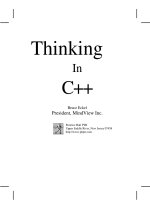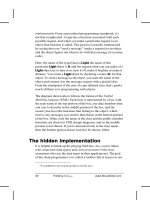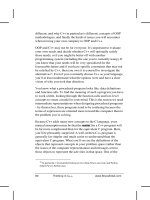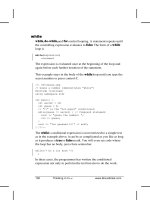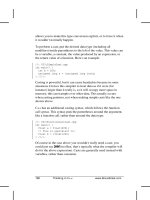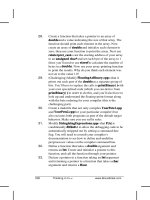Thinking in C plus plus (P11) pdf
Bạn đang xem bản rút gọn của tài liệu. Xem và tải ngay bản đầy đủ của tài liệu tại đây (154.48 KB, 50 trang )
480 Thinking in C++ www.BruceEckel.com
defined types by value during function calls. It’s so important, in
fact, that the compiler will automatically synthesize a copy-
constructor if you don’t provide one yourself, as you will see.
Passing & returning by value
To understand the need for the copy-constructor, consider the way
C handles passing and returning variables by value during function
calls. If you declare a function and make a function call,
int f(int x, char c);
int g = f(a, b);
how does the compiler know how to pass and return those
variables? It just knows! The range of the types it must deal with is
so small –
char
,
int
,
float
,
double
, and their variations – that this
information is built into the compiler.
If you figure out how to generate assembly code with your
compiler and determine the statements generated by the function
call to
f( )
, you’ll get the equivalent of:
push b
push a
call f()
add sp,4
mov g, register a
This code has been cleaned up significantly to make it generic; the
expressions for
b
and
a
will be different depending on whether the
variables are global (in which case they will be
_b
and
_a
) or local
(the compiler will index them off the stack pointer). This is also true
for the expression for
g
. The appearance of the call to
f( )
will
depend on your name-decoration scheme, and “register a” depends
on how the CPU registers are named within your assembler. The
logic behind the code, however, will remain the same.
In C and C++, arguments are first pushed on the stack from right to
left, then the function call is made. The calling code is responsible
11: References & the Copy-Constructor 481
for cleaning the arguments off the stack (which accounts for the
add sp,4
). But notice that to pass the arguments by value, the
compiler simply pushes copies on the stack – it knows how big
they are and that pushing those arguments makes accurate copies
of them.
The return value of
f( )
is placed in a register. Again, the compiler
knows everything there is to know about the return value type
because that type is built into the language, so the compiler can
return it by placing it in a register. With the primitive data types in
C, the simple act of copying the bits of the value is equivalent to
copying the object.
Passing & returning large objects
But now consider user-defined types. If you create a class and you
want to pass an object of that class by value, how is the compiler
supposed to know what to do? This is not a type built into the
compiler; it’s a type you have created.
To investigate this, you can start with a simple structure that is
clearly too large to return in registers:
//: C11:PassingBigStructures.cpp
struct Big {
char buf[100];
int i;
long d;
} B, B2;
Big bigfun(Big b) {
b.i = 100; // Do something to the argument
return b;
}
int main() {
B2 = bigfun(B);
} ///:~
Decoding the assembly output is a little more complicated here
because most compilers use “helper” functions instead of putting
482 Thinking in C++ www.BruceEckel.com
all functionality inline. In
main( )
, the call to
bigfun( )
starts as you
might guess – the entire contents of
B
is pushed on the stack. (Here,
you might see some compilers load registers with the address of
the
Big
and its size, then call a helper function to push the
Big
onto
the stack.)
In the previous code fragment, pushing the arguments onto the
stack was all that was required before making the function call. In
PassingBigStructures.cpp
, however, you’ll see an additional
action: the address of
B2
is pushed before making the call, even
though it’s obviously not an argument. To comprehend what’s
going on here, you need to understand the constraints on the
compiler when it’s making a function call.
Function-call stack frame
When the compiler generates code for a function call, it first pushes
all the arguments on the stack, then makes the call. Inside the
function, code is generated to move the stack pointer down even
farther to provide storage for the function’s local variables.
(“Down” is relative here; your machine may increment or
decrement the stack pointer during a push.) But during the
assembly-language CALL, the CPU pushes the address in the
program code where the function call
came from
, so the assembly-
language RETURN can use that address to return to the calling
point. This address is of course sacred, because without it your
program will get completely lost. Here’s what the stack frame looks
like after the CALL and the allocation of local variable storage in
the function:
Function arguments
Return address
Local variables
11: References & the Copy-Constructor 483
The code generated for the rest of the function expects the memory
to be laid out exactly this way, so that it can carefully pick from the
function arguments and local variables without touching the return
address. I shall call this block of memory, which is everything used
by a function in the process of the function call, the
function frame
.
You might think it reasonable to try to return values on the stack.
The compiler could simply push it, and the function could return
an offset to indicate how far down in the stack the return value
begins.
Re-entrancy
The problem occurs because functions in C and C++ support
interrupts; that is, the languages are
re-entrant
. They also support
recursive function calls. This means that at any point in the
execution of a program an interrupt can occur without breaking the
program. Of course, the person who writes the interrupt service
routine (ISR) is responsible for saving and restoring all the registers
that are used in the ISR, but if the ISR needs to use any memory
further down on the stack, this must be a safe thing to do. (You can
think of an ISR as an ordinary function with no arguments and
void
return value that saves and restores the CPU state. An ISR
function call is triggered by some hardware event instead of an
explicit call from within a program.)
Now imagine what would happen if an ordinary function tried to
return values on the stack. You can’t touch any part of the stack
that’s above the return address, so the function would have to push
the values below the return address. But when the assembly-
language RETURN is executed, the stack pointer must be pointing
to the return address (or right below it, depending on your
machine), so right before the RETURN, the function must move the
stack pointer up, thus clearing off all its local variables. If you’re
trying to return values on the stack below the return address, you
become vulnerable at that moment because an interrupt could
come along. The ISR would move the stack pointer down to hold
484 Thinking in C++ www.BruceEckel.com
its return address and its local variables and overwrite your return
value.
To solve this problem, the caller
could
be responsible for allocating
the extra storage on the stack for the return values before calling
the function. However, C was not designed this way, and C++
must be compatible. As you’ll see shortly, the C++ compiler uses a
more efficient scheme.
Your next idea might be to return the value in some global data
area, but this doesn’t work either. Reentrancy means that any
function can be an interrupt routine for any other function,
including the same function you’re currently inside
. Thus, if you put
the return value in a global area, you might return into the same
function, which would overwrite that return value. The same logic
applies to recursion.
The only safe place to return values is in the registers, so you’re
back to the problem of what to do when the registers aren’t large
enough to hold the return value. The answer is to push the address
of the return value’s destination on the stack as one of the function
arguments, and let the function copy the return information
directly into the destination. This not only solves all the problems,
it’s more efficient. It’s also the reason that, in
PassingBigStructures.cpp
, the compiler pushes the address of
B2
before the call to
bigfun( )
in
main( )
. If you look at the assembly
output for
bigfun( )
, you can see it expects this hidden argument
and performs the copy to the destination
inside
the function.
Bitcopy versus initialization
So far, so good. There’s a workable process for passing and
returning large simple structures. But notice that all you have is a
way to copy the bits from one place to another, which certainly
works fine for the primitive way that C looks at variables. But in
C++ objects can be much more sophisticated than a patch of bits;
they have meaning. This meaning may not respond well to having
its bits copied.
11: References & the Copy-Constructor 485
Consider a simple example: a class that knows how many objects of
its type exist at any one time. From Chapter 10, you know the way
to do this is by including a
static
data member:
//: C11:HowMany.cpp
// A class that counts its objects
#include <fstream>
#include <string>
using namespace std;
ofstream out("HowMany.out");
class HowMany {
static int objectCount;
public:
HowMany() { objectCount++; }
static void print(const string& msg = "") {
if(msg.size() != 0) out << msg << ": ";
out << "objectCount = "
<< objectCount << endl;
}
~HowMany() {
objectCount ;
print("~HowMany()");
}
};
int HowMany::objectCount = 0;
// Pass and return BY VALUE:
HowMany f(HowMany x) {
x.print("x argument inside f()");
return x;
}
int main() {
HowMany h;
HowMany::print("after construction of h");
HowMany h2 = f(h);
HowMany::print("after call to f()");
} ///:~
The class
HowMany
contains a
static
int objectCount
and a
static
member function
print( )
to report the value of that
objectCount
,
486 Thinking in C++ www.BruceEckel.com
along with an optional message argument. The constructor
increments the count each time an object is created, and the
destructor decrements it.
The output, however, is not what you would expect:
after construction of h: objectCount = 1
x argument inside f(): objectCount = 1
~HowMany(): objectCount = 0
after call to f(): objectCount = 0
~HowMany(): objectCount = -1
~HowMany(): objectCount = -2
After
h
is created, the object count is one, which is fine. But after
the call to
f( )
you would expect to have an object count of two,
because
h2
is now in scope as well. Instead, the count is zero, which
indicates something has gone horribly wrong. This is confirmed by
the fact that the two destructors at the end make the object count go
negative, something that should never happen.
Look at the point inside
f( )
, which occurs after the argument is
passed by value. This means the original object
h
exists outside the
function frame, and there’s an additional object
inside
the function
frame, which is the copy that has been passed by value. However,
the argument has been passed using C’s primitive notion of
bitcopying, whereas the C++
HowMany
class requires true
initialization to maintain its integrity, so the default bitcopy fails to
produce the desired effect.
When the local object goes out of scope at the end of the call to
f( )
,
the destructor is called, which decrements
objectCount
, so outside
the function,
objectCount
is zero. The creation of
h2
is also
performed using a bitcopy, so the constructor isn’t called there
either, and when
h
and
h2
go out of scope, their destructors cause
the negative values of
objectCount
.
11: References & the Copy-Constructor 487
Copy-construction
The problem occurs because the compiler makes an assumption
about how to create
a new object from an existing object
. When you
pass an object by value, you create a new object, the passed object
inside the function frame, from an existing object, the original
object outside the function frame. This is also often true when
returning an object from a function. In the expression
HowMany h2 = f(h);
h2
, a previously unconstructed object, is created from the return
value of
f( )
, so again a new object is created from an existing one.
The compiler’s assumption is that you want to perform this
creation using a bitcopy, and in many cases this may work fine, but
in
HowMany
it doesn’t fly because the meaning of initialization
goes beyond simply copying. Another common example occurs if
the class contains pointers – what do they point to, and should you
copy them or should they be connected to some new piece of
memory?
Fortunately, you can intervene in this process and prevent the
compiler from doing a bitcopy. You do this by defining your own
function to be used whenever the compiler needs to make a new
object from an existing object. Logically enough, you’re making a
new object, so this function is a constructor, and also logically
enough, the single argument to this constructor has to do with the
object you’re constructing from. But that object can’t be passed into
the constructor by value because you’re trying to
define
the function
that handles passing by value, and syntactically it doesn’t make
sense to pass a pointer because, after all, you’re creating the new
object from an existing object. Here, references come to the rescue,
so you take the reference of the source object. This function is called
the
copy-constructor
and is often referred to as
X(X&)
, which is its
appearance for a class called
X
.
488 Thinking in C++ www.BruceEckel.com
If you create a copy-constructor, the compiler will not perform a
bitcopy when creating a new object from an existing one. It will
always call your copy-constructor. So, if you don’t create a copy-
constructor, the compiler will do something sensible, but you have
the choice of taking over complete control of the process.
Now it’s possible to fix the problem in
HowMany.cpp
:
//: C11:HowMany2.cpp
// The copy-constructor
#include <fstream>
#include <string>
using namespace std;
ofstream out("HowMany2.out");
class HowMany2 {
string name; // Object identifier
static int objectCount;
public:
HowMany2(const string& id = "") : name(id) {
++objectCount;
print("HowMany2()");
}
~HowMany2() {
objectCount;
print("~HowMany2()");
}
// The copy-constructor:
HowMany2(const HowMany2& h) : name(h.name) {
name += " copy";
++objectCount;
print("HowMany2(const HowMany2&)");
}
void print(const string& msg = "") const {
if(msg.size() != 0)
out << msg << endl;
out << '\t' << name << ": "
<< "objectCount = "
<< objectCount << endl;
}
};
int HowMany2::objectCount = 0;
11: References & the Copy-Constructor 489
// Pass and return BY VALUE:
HowMany2 f(HowMany2 x) {
x.print("x argument inside f()");
out << "Returning from f()" << endl;
return x;
}
int main() {
HowMany2 h("h");
out << "Entering f()" << endl;
HowMany2 h2 = f(h);
h2.print("h2 after call to f()");
out << "Call f(), no return value" << endl;
f(h);
out << "After call to f()" << endl;
} ///:~
There are a number of new twists thrown in here so you can get a
better idea of what’s happening. First, the
string
name
acts as an
object identifier when information about that object is printed. In
the constructor, you can put an identifier string (usually the name
of the object) that is copied to
name
using the
string
constructor.
The default
= ""
creates an empty
string
. The constructor
increments the
objectCount
as before, and the destructor
decrements it.
Next is the copy-constructor,
HowMany2(const HowMany2&)
.
The copy-constructor can create a new object only from an existing
one, so the existing object’s name is copied to
name
, followed by
the word “copy” so you can see where it came from. If you look
closely, you’ll see that the call
name(h.name)
in the constructor
initializer list is actually calling the
string
copy-constructor.
Inside the copy-constructor, the object count is incremented just as
it is inside the normal constructor. This means you’ll now get an
accurate object count when passing and returning by value.
The
print( )
function has been modified to print out a message, the
object identifier, and the object count. It must now access the
name
490 Thinking in C++ www.BruceEckel.com
data of a particular object, so it can no longer be a
static
member
function.
Inside
main( )
, you can see that a second call to
f( )
has been added.
However, this call uses the common C approach of ignoring the
return value. But now that you know how the value is returned
(that is, code
inside
the function handles the return process, putting
the result in a destination whose address is passed as a hidden
argument), you might wonder what happens when the return
value is ignored. The output of the program will throw some
illumination on this.
Before showing the output, here’s a little program that uses
iostreams to add line numbers to any file:
//: C11:Linenum.cpp
//{T} Linenum.cpp
// Add line numbers
#include " /require.h"
#include <vector>
#include <string>
#include <fstream>
#include <iostream>
#include <cmath>
using namespace std;
int main(int argc, char* argv[]) {
requireArgs(argc, 1, "Usage: linenum file\n"
"Adds line numbers to file");
ifstream in(argv[1]);
assure(in, argv[1]);
string line;
vector<string> lines;
while(getline(in, line)) // Read in entire file
lines.push_back(line);
if(lines.size() == 0) return 0;
int num = 0;
// Number of lines in file determines width:
const int width = int(log10(lines.size())) + 1;
for(int i = 0; i < lines.size(); i++) {
cout.setf(ios::right, ios::adjustfield);
cout.width(width);
11: References & the Copy-Constructor 491
cout << ++num << ") " << lines[i] << endl;
}
} ///:~
The entire file is read into a
vector<string>
, using the same code
that you’ve seen earlier in the book. When printing the line
numbers, we’d like all the lines to be aligned with each other, and
this requires adjusting for the number of lines in the file so that the
width allowed for the line numbers is consistent. We can easily
determine the number of lines using
vector::size( )
, but what we
really need to know is whether there are more than 10 lines, 100
lines, 1,000 lines, etc. If you take the logarithm, base 10, of the
number of lines in the file, truncate it to an
int
and add one to the
value, you’ll find out the maximum width that your line count will
be.
You’ll notice a couple of strange calls inside the
for
loop:
setf( )
and
width( )
. These are
ostream
calls that allow you to control, in this
case, the justification and width of the output. However, they must
be called each time a line is output and that is why they are inside
the
for
loop. Volume 2 of this book has an entire chapter explaining
iostreams that will tell you more about these calls as well as other
ways to control iostreams.
When
Linenum.cpp
is applied to
HowMany2.out
, the result is
1) HowMany2()
2) h: objectCount = 1
3) Entering f()
4) HowMany2(const HowMany2&)
5) h copy: objectCount = 2
6) x argument inside f()
7) h copy: objectCount = 2
8) Returning from f()
9) HowMany2(const HowMany2&)
10) h copy copy: objectCount = 3
11) ~HowMany2()
12) h copy: objectCount = 2
13) h2 after call to f()
14) h copy copy: objectCount = 2
492 Thinking in C++ www.BruceEckel.com
15) Call f(), no return value
16) HowMany2(const HowMany2&)
17) h copy: objectCount = 3
18) x argument inside f()
19) h copy: objectCount = 3
20) Returning from f()
21) HowMany2(const HowMany2&)
22) h copy copy: objectCount = 4
23) ~HowMany2()
24) h copy: objectCount = 3
25) ~HowMany2()
26) h copy copy: objectCount = 2
27) After call to f()
28) ~HowMany2()
29) h copy copy: objectCount = 1
30) ~HowMany2()
31) h: objectCount = 0
As you would expect, the first thing that happens is that the normal
constructor is called for
h
, which increments the object count to
one. But then, as
f( )
is entered, the copy-constructor is quietly
called by the compiler to perform the pass-by-value. A new object
is created, which is the copy of
h
(thus the name “h copy”) inside
the function frame of
f( )
, so the object count becomes two, courtesy
of the copy-constructor.
Line eight indicates the beginning of the return from
f( )
. But before
the local variable “h copy” can be destroyed (it goes out of scope at
the end of the function), it must be copied into the return value,
which happens to be
h2
. A previously unconstructed object (
h2
) is
created from an existing object (the local variable inside
f( )
), so of
course the copy-constructor is used again in line nine. Now the
name becomes “h copy copy” for
h2
’s identifier because it’s being
copied from the copy that is the local object inside
f( )
. After the
object is returned, but before the function ends, the object count
becomes temporarily three, but then the local object “h copy” is
destroyed. After the call to
f( )
completes in line 13, there are only
two objects,
h
and
h2
, and you can see that
h2
did indeed end up as
“h copy copy.”
11: References & the Copy-Constructor 493
Temporary objects
Line 15 begins the call to
f(h)
, this time ignoring the return value.
You can see in line 16 that the copy-constructor is called just as
before to pass the argument in. And also, as before, line 21 shows
the copy-constructor is called for the return value. But the copy-
constructor must have an address to work on as its destination (a
this
pointer). Where does this address come from?
It turns out the compiler can create a temporary object whenever it
needs one to properly evaluate an expression. In this case it creates
one you don’t even see to act as the destination for the ignored
return value of
f( )
. The lifetime of this temporary object is as short
as possible so the landscape doesn’t get cluttered up with
temporaries waiting to be destroyed and taking up valuable
resources. In some cases, the temporary might immediately be
passed to another function, but in this case it isn’t needed after the
function call, so as soon as the function call ends by calling the
destructor for the local object (lines 23 and 24), the temporary object
is destroyed (lines 25 and 26).
Finally, in lines 28-31, the
h2
object is destroyed, followed by
h
, and
the object count goes correctly back to zero.
Default copy-constructor
Because the copy-constructor implements pass and return by value,
it’s important that the compiler creates one for you in the case of
simple structures – effectively, the same thing it does in C.
However, all you’ve seen so far is the default primitive behavior: a
bitcopy.
When more complex types are involved, the C++ compiler will still
automatically create a copy-constructor if you don’t make one.
Again, however, a bitcopy doesn’t make sense, because it doesn’t
necessarily implement the proper meaning.
494 Thinking in C++ www.BruceEckel.com
Here’s an example to show the more intelligent approach the
compiler takes. Suppose you create a new class composed of objects
of several existing classes. This is called, appropriately enough,
composition
, and it’s one of the ways you can make new classes from
existing classes. Now take the role of a naive user who’s trying to
solve a problem quickly by creating a new class this way. You don’t
know about copy-constructors, so you don’t create one. The
example demonstrates what the compiler does while creating the
default copy-constructor for your new class:
//: C11:DefaultCopyConstructor.cpp
// Automatic creation of the copy-constructor
#include <iostream>
#include <string>
using namespace std;
class WithCC { // With copy-constructor
public:
// Explicit default constructor required:
WithCC() {}
WithCC(const WithCC&) {
cout << "WithCC(WithCC&)" << endl;
}
};
class WoCC { // Without copy-constructor
string id;
public:
WoCC(const string& ident = "") : id(ident) {}
void print(const string& msg = "") const {
if(msg.size() != 0) cout << msg << ": ";
cout << id << endl;
}
};
class Composite {
WithCC withcc; // Embedded objects
WoCC wocc;
public:
Composite() : wocc("Composite()") {}
void print(const string& msg = "") const {
wocc.print(msg);
11: References & the Copy-Constructor 495
}
};
int main() {
Composite c;
c.print("Contents of c");
cout << "Calling Composite copy-constructor"
<< endl;
Composite c2 = c; // Calls copy-constructor
c2.print("Contents of c2");
} ///:~
The class
WithCC
contains a copy-constructor, which simply
announces that it has been called, and this brings up an interesting
issue. In the class
Composite
, an object of
WithCC
is created using
a default constructor. If there were no constructors at all in
WithCC
, the compiler would automatically create a default
constructor, which would do nothing in this case. However, if you
add a copy-constructor, you’ve told the compiler you’re going to
handle constructor creation, so it no longer creates a default
constructor for you and will complain unless you explicitly create a
default constructor as was done for
WithCC
.
The class
WoCC
has no copy-constructor, but its constructor will
store a message in an internal
string
that can be printed out using
print( )
. This constructor is explicitly called in
Composite
’s
constructor initializer list (briefly introduced in Chapter 8 and
covered fully in Chapter 14). The reason for this becomes apparent
later.
The class
Composite
has member objects of both
WithCC
and
WoCC
(note the embedded object
wocc
is initialized in the
constructor-initializer list, as it must be), and no explicitly defined
copy-constructor. However, in
main( )
an object is created using the
copy-constructor in the definition:
Composite c2 = c;
496 Thinking in C++ www.BruceEckel.com
The copy-constructor for
Composite
is created automatically by the
compiler, and the output of the program reveals the way that it is
created:
Contents of c: Composite()
Calling Composite copy-constructor
WithCC(WithCC&)
Contents of c2: Composite()
To create a copy-constructor for a class that uses composition (and
inheritance, which is introduced in Chapter 14), the compiler
recursively calls the copy-constructors for all the member objects
and base classes. That is, if the member object also contains another
object, its copy-constructor is also called. So in this case, the
compiler calls the copy-constructor for
WithCC
. The output shows
this constructor being called. Because
WoCC
has no copy-
constructor, the compiler creates one for it that just performs a
bitcopy, and calls that inside the
Composite
copy-constructor. The
call to
Composite::print( )
in main shows that this happens because
the contents of
c2.wocc
are identical to the contents of
c.wocc
. The
process the compiler goes through to synthesize a copy-constructor
is called
memberwise initialization
.
It’s always best to create your own copy-constructor instead of
letting the compiler do it for you. This guarantees that it will be
under your control.
Alternatives to copy-construction
At this point your head may be swimming, and you might be
wondering how you could have possibly written a working class
without knowing about the copy-constructor. But remember: You
need a copy-constructor only if you’re going to pass an object of
your class
by value
. If that never happens, you don’t need a copy-
constructor.
11: References & the Copy-Constructor 497
Preventing pass-by-value
“But,” you say, “if I don’t make a copy-constructor, the compiler
will create one for me. So how do I know that an object will never
be passed by value?”
There’s a simple technique for preventing pass-by-value: declare a
private
copy-constructor. You don’t even need to create a
definition, unless one of your member functions or a
friend
function needs to perform a pass-by-value. If the user tries to pass
or return the object by value, the compiler will produce an error
message because the copy-constructor is
private
. It can no longer
create a default copy-constructor because you’ve explicitly stated
that you’re taking over that job.
Here’s an example:
//: C11:NoCopyConstruction.cpp
// Preventing copy-construction
class NoCC {
int i;
NoCC(const NoCC&); // No definition
public:
NoCC(int ii = 0) : i(ii) {}
};
void f(NoCC);
int main() {
NoCC n;
//! f(n); // Error: copy-constructor called
//! NoCC n2 = n; // Error: c-c called
//! NoCC n3(n); // Error: c-c called
} ///:~
Notice the use of the more general form
NoCC(const NoCC&);
using the
const
.
498 Thinking in C++ www.BruceEckel.com
Functions that modify outside objects
Reference syntax is nicer to use than pointer syntax, yet it clouds
the meaning for the reader. For example, in the iostreams library
one overloaded version of the
get( )
function takes a
char&
as an
argument, and the whole point of the function is to modify its
argument by inserting the result of the
get( )
. However, when you
read code using this function it’s not immediately obvious to you
that the outside object is being modified:
char c;
cin.get(c);
Instead, the function call looks like a pass-by-value, which suggests
the outside object is
not
modified.
Because of this, it’s probably safer from a code maintenance
standpoint to use pointers when you’re passing the address of an
argument to modify. If you
always
pass addresses as
const
references
except
when you intend to modify the outside object via
the address, where you pass by non-
const
pointer, then your code
is far easier for the reader to follow.
Pointers to members
A pointer is a variable that holds the address of some location. You
can change what a pointer selects at runtime, and the destination of
the pointer can be either data or a function. The C++
pointer-to-member
follows this same concept, except that what it
selects is a location inside a class. The dilemma here is that a
pointer needs an address, but there is no “address” inside a class;
selecting a member of a class means offsetting into that class. You
can’t produce an actual address until you combine that offset with
the starting address of a particular object. The syntax of pointers to
members requires that you select an object at the same time you’re
dereferencing the pointer to member.
11: References & the Copy-Constructor 499
To understand this syntax, consider a simple structure, with a
pointer
sp
and an object
so
for this structure. You can select
members with the syntax shown:
//: C11:SimpleStructure.cpp
struct Simple { int a; };
int main() {
Simple so, *sp = &so;
sp->a;
so.a;
} ///:~
Now suppose you have an ordinary pointer to an integer,
ip
. To
access what
ip
is pointing to, you dereference the pointer with a ‘
*
’:
*ip = 4;
Finally, consider what happens if you have a pointer that happens
to point to something inside a class object, even if it does in fact
represent an offset into the object. To access what it’s pointing at,
you must dereference it with
*
. But it’s an offset into an object, so
you must also refer to that particular object. Thus, the
*
is combined
with the object dereference. So the new syntax becomes
–>*
for a
pointer to an object, and
.*
for the object or a reference, like this:
objectPointer->*pointerToMember = 47;
object.*pointerToMember = 47;
Now, what is the syntax for defining
pointerToMember
? Like any
pointer, you have to say what type it’s pointing at, and you use a
*
in the definition. The only difference is that you must say what
class of objects this pointer-to-member is used with. Of course, this
is accomplished with the name of the class and the scope resolution
operator. Thus,
int ObjectClass::*pointerToMember;
defines a pointer-to-member variable called
pointerToMember
that
points to any
int
inside
ObjectClass
. You can also initialize the
pointer-to-member when you define it (or at any other time):
500 Thinking in C++ www.BruceEckel.com
int ObjectClass::*pointerToMember = &ObjectClass::a;
There is actually no “address” of
ObjectClass::a
because you’re just
referring to the class and not an object of that class. Thus,
&ObjectClass::a
can be used only as pointer-to-member syntax.
Here’s an example that shows how to create and use pointers to
data members:
//: C11:PointerToMemberData.cpp
#include <iostream>
using namespace std;
class Data {
public:
int a, b, c;
void print() const {
cout << "a = " << a << ", b = " << b
<< ", c = " << c << endl;
}
};
int main() {
Data d, *dp = &d;
int Data::*pmInt = &Data::a;
dp->*pmInt = 47;
pmInt = &Data::b;
d.*pmInt = 48;
pmInt = &Data::c;
dp->*pmInt = 49;
dp->print();
} ///:~
Obviously, these are too awkward to use anywhere except for
special cases (which is exactly what they were intended for).
Also, pointers to members are quite limited: they can be assigned
only to a specific location inside a class. You could not, for example,
increment or compare them as you can with ordinary pointers.
11: References & the Copy-Constructor 501
Functions
A similar exercise produces the pointer-to-member syntax for
member functions. A pointer to a function (introduced at the end of
Chapter 3) is defined like this:
int (*fp)(float);
The parentheses around
(*fp)
are necessary to force the compiler to
evaluate the definition properly. Without them this would appear
to be a function that returns an
int*
.
Parentheses also play an important role when defining and using
pointers to member functions. If you have a function inside a class,
you define a pointer to that member function by inserting the class
name and scope resolution operator into an ordinary function
pointer definition:
//: C11:PmemFunDefinition.cpp
class Simple2 {
public:
int f(float) const { return 1; }
};
int (Simple2::*fp)(float) const;
int (Simple2::*fp2)(float) const = &Simple2::f;
int main() {
fp = &Simple2::f;
} ///:~
In the definition for
fp2
you can see that a pointer to member
function can also be initialized when it is created, or at any other
time. Unlike non-member functions, the
&
is
not
optional when
taking the address of a member function. However, you can give
the function identifier without an argument list, because overload
resolution can be determined by the type of the pointer to member.
An example
The value of a pointer is that you can change what it points to at
runtime, which provides an important flexibility in your
programming because through a pointer you can select or change
502 Thinking in C++ www.BruceEckel.com
behavior
at runtime. A pointer-to-member is no different; it allows
you to choose a member at runtime. Typically, your classes will
only have member functions publicly visible (data members are
usually considered part of the underlying implementation), so the
following example selects member functions at runtime.
//: C11:PointerToMemberFunction.cpp
#include <iostream>
using namespace std;
class Widget {
public:
void f(int) const { cout << "Widget::f()\n"; }
void g(int) const { cout << "Widget::g()\n"; }
void h(int) const { cout << "Widget::h()\n"; }
void i(int) const { cout << "Widget::i()\n"; }
};
int main() {
Widget w;
Widget* wp = &w;
void (Widget::*pmem)(int) const = &Widget::h;
(w.*pmem)(1);
(wp->*pmem)(2);
} ///:~
Of course, it isn’t particularly reasonable to expect the casual user
to create such complicated expressions. If the user must directly
manipulate a pointer-to-member, then a
typedef
is in order. To
really clean things up, you can use the pointer-to-member as part of
the internal implementation mechanism. Here’s the preceding
example using a pointer-to-member
inside
the class. All the user
needs to do is pass a number in to select a function.
1
//: C11:PointerToMemberFunction2.cpp
#include <iostream>
using namespace std;
1
Thanks to Owen Mortensen for this example
11: References & the Copy-Constructor 503
class Widget {
void f(int) const { cout << "Widget::f()\n"; }
void g(int) const { cout << "Widget::g()\n"; }
void h(int) const { cout << "Widget::h()\n"; }
void i(int) const { cout << "Widget::i()\n"; }
enum { cnt = 4 };
void (Widget::*fptr[cnt])(int) const;
public:
Widget() {
fptr[0] = &Widget::f; // Full spec required
fptr[1] = &Widget::g;
fptr[2] = &Widget::h;
fptr[3] = &Widget::i;
}
void select(int i, int j) {
if(i < 0 || i >= cnt) return;
(this->*fptr[i])(j);
}
int count() { return cnt; }
};
int main() {
Widget w;
for(int i = 0; i < w.count(); i++)
w.select(i, 47);
} ///:~
In the class interface and in
main( )
, you can see that the entire
implementation, including the functions, has been hidden away.
The code must even ask for the
count( )
of functions. This way, the
class implementer can change the quantity of functions in the
underlying implementation without affecting the code where the
class is used.
The initialization of the pointers-to-members in the constructor
may seem overspecified. Shouldn’t you be able to say
fptr[1] = &g;
because the name
g
occurs in the member function, which is
automatically in the scope of the class? The problem is this doesn’t
conform to the pointer-to-member syntax, which is required so
504 Thinking in C++ www.BruceEckel.com
everyone, especially the compiler, can figure out what’s going on.
Similarly, when the pointer-to-member is dereferenced, it seems
like
(this->*fptr[i])(j);
is also over-specified;
this
looks redundant. Again, the syntax
requires that a pointer-to-member always be bound to an object
when it is dereferenced.
Summary
Pointers in C++ are almost identical to pointers in C, which is good.
Otherwise, a lot of C code wouldn’t compile properly under C++.
The only compile-time errors you will produce occur with
dangerous assignments. If these are in fact what are intended, the
compile-time errors can be removed with a simple (and explicit!)
cast.
C++ also adds the
reference
from Algol and Pascal, which is like a
constant pointer that is automatically dereferenced by the compiler.
A reference holds an address, but you treat it like an object.
References are essential for clean syntax with operator overloading
(the subject of the next chapter), but they also add syntactic
convenience for passing and returning objects for ordinary
functions.
The copy-constructor takes a reference to an existing object of the
same type as its argument, and it is used to create a new object
from an existing one. The compiler automatically calls the copy-
constructor when you pass or return an object by value. Although
the compiler will automatically create a copy-constructor for you, if
you think one will be needed for your class, you should always
define it yourself to ensure that the proper behavior occurs. If you
don’t want the object passed or returned by value, you should
create a private copy-constructor.
